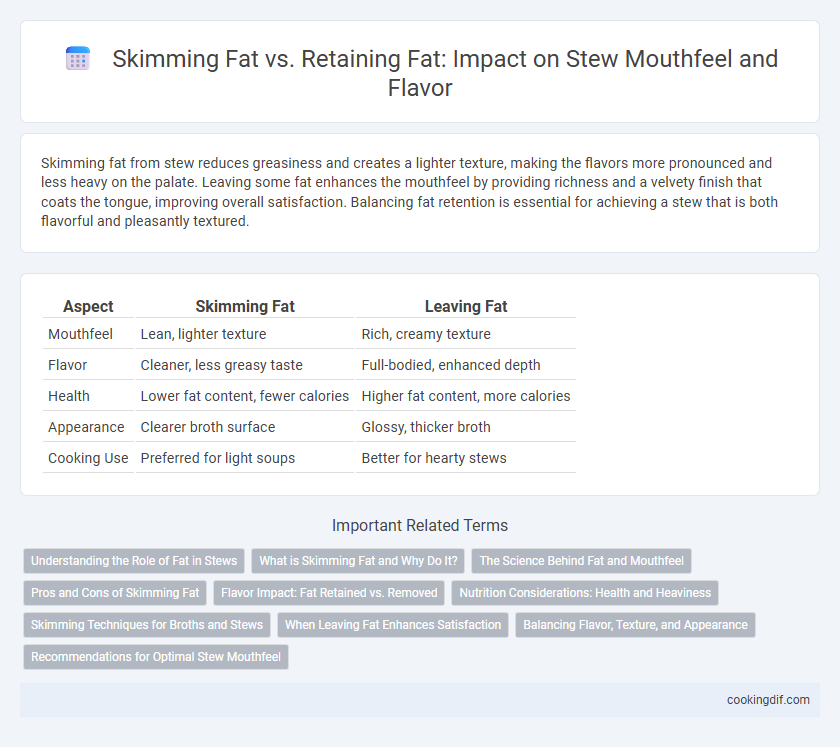Skimming fat from stew reduces greasiness and creates a lighter texture, making the flavors more pronounced and less heavy on the palate. Leaving some fat enhances the mouthfeel by providing richness and a velvety finish that coats the tongue, improving overall satisfaction. Balancing fat retention is essential for achieving a stew that is both flavorful and pleasantly textured.
Table of Comparison
| Aspect | Skimming Fat | Leaving Fat |
|---|---|---|
| Mouthfeel | Lean, lighter texture | Rich, creamy texture |
| Flavor | Cleaner, less greasy taste | Full-bodied, enhanced depth |
| Health | Lower fat content, fewer calories | Higher fat content, more calories |
| Appearance | Clearer broth surface | Glossy, thicker broth |
| Cooking Use | Preferred for light soups | Better for hearty stews |
Understanding the Role of Fat in Stews
Fat in stew plays a crucial role in enhancing mouthfeel by providing a rich, velvety texture that coats the palate and balances flavors. Skimming fat removes excess greasiness, preventing the stew from feeling heavy, but retaining some fat preserves the stew's depth and satiety. Understanding this balance allows for a stew that is both flavorful and smooth, highlighting the importance of fat as a key component in the culinary experience.
What is Skimming Fat and Why Do It?
Skimming fat involves removing the layer of oil and grease that rises to the surface during the cooking of stew, which helps create a cleaner, less greasy broth. This process improves the stew's clarity and can make it healthier by reducing excess saturated fat. Leaving some fat instead enhances the mouthfeel, providing richness and a fuller texture that contributes to a more satisfying eating experience.
The Science Behind Fat and Mouthfeel
Fat molecules in stew play a crucial role in enhancing mouthfeel by coating the palate and creating a rich, velvety texture that heightens flavor perception. Skimming fat removes these lipid compounds, potentially leading to a thinner, less satisfying mouthfeel, while leaving some fat ensures a balanced viscosity and a fuller sensory experience. The interaction between fat globules and protein emulsifiers in the stew influences the creaminess and overall tactile sensation, demonstrating how controlled fat retention can optimize both taste and texture.
Pros and Cons of Skimming Fat
Skimming fat from stew reduces grease, resulting in a cleaner, lighter broth that highlights delicate flavors without overwhelming richness. However, removing fat can sacrifice mouthfeel, as fat enhances texture and adds a satisfying creaminess that enriches the overall taste experience. Leaving some fat maintains the stew's body and fullness, but excessive fat may make it heavy or greasy.
Flavor Impact: Fat Retained vs. Removed
Skimming fat from stew reduces the richness, resulting in a lighter flavor profile but potentially sacrificing the fullness of mouthfeel that fat provides. Keeping the fat enhances the stew's depth and complexity, allowing flavors to meld and intensify, while delivering a velvety, satisfying texture. Fat retention preserves aromatic compounds and flavor oils, contributing to a more robust and indulgent eating experience.
Nutrition Considerations: Health and Heaviness
Skimming fat from stew reduces calorie content and lowers saturated fat intake, supporting heart health and weight management. Leaving fat enhances mouthfeel by providing richness and flavor, but increases heaviness and overall fat consumption. Balancing fat removal with desired texture helps manage nutrition without sacrificing the stew's sensory appeal.
Skimming Techniques for Broths and Stews
Skimming fat from broths and stews enhances clarity and prevents greasy flavors, which can overshadow delicate ingredients. Effective skimming techniques involve using a fine mesh skimmer or ladle to gently remove fat droplets that rise to the surface during simmering, ensuring a cleaner and more refined broth. Leaving a minimal amount of fat can improve mouthfeel by adding richness without compromising the stew's overall balance or texture.
When Leaving Fat Enhances Satisfaction
Leaving fat in stew enhances mouthfeel by providing a rich, velvety texture that coats the palate and intensifies flavor perception. The presence of marbled fat from cuts like chuck or brisket allows the stew to maintain a luscious consistency, improving overall satisfaction. Fat also acts as a flavor carrier, releasing savory compounds slowly through cooking, which deepens the stew's complexity and appeal.
Balancing Flavor, Texture, and Appearance
Skimming fat from stew reduces greasiness and clarifies the broth, enhancing a clean flavor and appealing appearance, while leaving some fat improves mouthfeel by adding richness and a silky texture. Achieving balance involves removing excess fat to prevent heaviness yet retaining enough to preserve depth and body in the stew's taste and texture. This technique ensures the stew is flavorful without being oily, maintaining an inviting look and satisfying sensory experience.
Recommendations for Optimal Stew Mouthfeel
Skimming fat from stew improves clarity and reduces greasiness, enhancing overall texture, while leaving some fat preserves richness and a velvety mouthfeel. For optimal stew mouthfeel, remove excess fat but retain a thin layer to balance smoothness and flavor depth. Using a fat separator or chilling the stew to solidify fat before skimming ensures precise control over fat content without sacrificing creaminess.
Skimming Fat vs Leaving Fat for Mouthfeel Infographic

 cookingdif.com
cookingdif.com